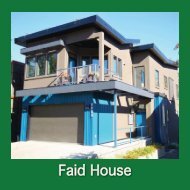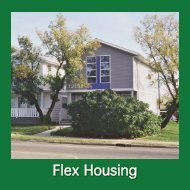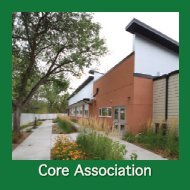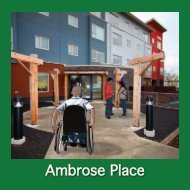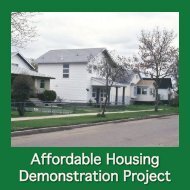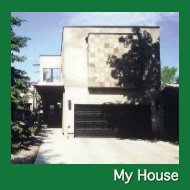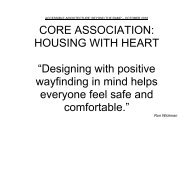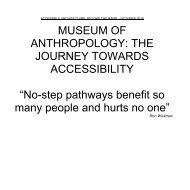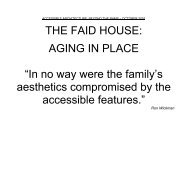Ambrose Place
Project by Ron Wickman Architect
Project by Ron Wickman Architect
Create successful ePaper yourself
Turn your PDF publications into a flip-book with our unique Google optimized e-Paper software.
ACCESSIBLE ARCHITECTURE: BEYOND THE RAMP – OCTOBER 2016<br />
AMBROSE PLACE:<br />
A HEALING HOME<br />
“Residents have finally found<br />
home.”<br />
Ron Wickman<br />
179
ACCESSIBLE ARCHITECTURE: BEYOND THE RAMP – OCTOBER 2016<br />
In 2006, NiGiNan Housing Ventures, a not-for-profit group hired me to design a housing project for<br />
persons who are currently homeless. <strong>Ambrose</strong> <strong>Place</strong> primarily serves homeless individuals and<br />
couples of Aboriginal descent: chronic substance abusers who cannot be housed within existing<br />
facilities. Some may have been barred from existing facilities, while others may feel that the existing<br />
facilities do not meet their requirements and thus do not use them. Many of the individuals suffer<br />
from concurrent mental health issues such as dual addictions. The housing focuses upon improving<br />
the quality of the individual’s life, health, and well-being, looking beyond the labels of addictions or<br />
disability to look at the whole person including their history, culture, mental, physical, and spiritual<br />
needs. The role of the practitioner is to educate the person on options and consequences, thus<br />
enabling the individual to improve their quality of life, health, and wellbeing through gradual nonjudgmental<br />
means. <strong>Ambrose</strong> <strong>Place</strong> meets these standards.<br />
The architecture adheres to the principles of American sculptor Davis Best of Burning Man fame.<br />
“…it’s more important who goes inside…A building itself should never be more important than the<br />
people.” The beauty of this project is not just based on its visual aspects, but in its ability to transform<br />
people’s lives. There is tremendous beauty in living with grace, safety, and confidence.<br />
The design of <strong>Ambrose</strong> <strong>Place</strong> provides an environment that facilitates individual growth and<br />
development and enhances the individual’s self-esteem and capacity for independent living.<br />
Residents need to have a sense of control over their own lives. The project transformed six raw,<br />
vacant lots on the south side of 106 th Avenue between 96 th and 97 th Streets in downtown Edmonton.<br />
Through its enhancement of the built environment with social housing that enhances the quality of<br />
life of its residents, <strong>Ambrose</strong> <strong>Place</strong> reaps both social and economic benefits for the City of<br />
Edmonton.<br />
180
ACCESSIBLE ARCHITECTURE: BEYOND THE RAMP – OCTOBER 2016<br />
The above image shows <strong>Ambrose</strong> <strong>Place</strong> within its urban context.<br />
Both within <strong>Ambrose</strong> <strong>Place</strong> and the community where it is located, accessibility is a guiding<br />
principle. The building is strategically located in the inner city close to many important amenities,<br />
which comprise part of the individual residents’ daily lives. Easy access to health-care services -<br />
located only a half block to the east - a commercial shopping street - located only a block to the<br />
west contribute to the residents’ quality of life. The downtown police station, just north of <strong>Ambrose</strong><br />
<strong>Place</strong> provides safety for all its residents. The building increases the density in the community by<br />
maximizing the building pocket size and allowable height at four storeys, a height which harmonizes<br />
with its surrounding community. It is designed at a scale to fit within its urban context.<br />
181
ACCESSIBLE ARCHITECTURE: BEYOND THE RAMP – OCTOBER 2016<br />
The above image shows an exterior view of <strong>Ambrose</strong> <strong>Place</strong>.<br />
The modulated roofline and walls with projecting bay windows provide depth and complexity to the<br />
building form. The four singular pieces of the building are different colors—red, white, blue, and<br />
yellow—making each piece more identifiable. The natural materials used are located close to where<br />
individuals can touch and smell. The landscape design incorporates the four elements of Earth,<br />
Fire, Water, and Medicine, elements central to the First Nations’ culture and intended to bring<br />
additional healing and relevance to its inhabitants.<br />
182
ACCESSIBLE ARCHITECTURE: BEYOND THE RAMP – OCTOBER 2016<br />
The above image shows the main entrance.<br />
The new facility consists of four floors, plus an underground parking garage. The top floors contain<br />
42 dwellings: 36 bachelor suites and 6 two-bedroom suites, The main floor consists of shared<br />
spaces that include dining room, exercise and tub room, TV and recreation areas, a Quiet Room,<br />
staff offices, staff laundry and more. A circular Smudging Hut located in the central lobby focuses<br />
as both a physical and spiritual reference point, inside and outside, for residents, staff, and visitors<br />
including the neighboring community. As the heart of the building, the Smudging Hut is central to<br />
the design concept and is the most decorated and detailed part of the building.<br />
183
ACCESSIBLE ARCHITECTURE: BEYOND THE RAMP – OCTOBER 2016<br />
The above plan shows the main floor of <strong>Ambrose</strong> <strong>Place</strong>, which houses all the amenity services<br />
including the smudge room.<br />
184
ACCESSIBLE ARCHITECTURE: BEYOND THE RAMP – OCTOBER 2016<br />
The above plan shows the second, third, and fourth floors of <strong>Ambrose</strong> <strong>Place</strong> which houses the 42<br />
living units, all with their own kitchens and bathrooms.<br />
185
ACCESSIBLE ARCHITECTURE: BEYOND THE RAMP – OCTOBER 2016<br />
The above images show an exterior view of the Smudging Hut and Landscaping.<br />
186
ACCESSIBLE ARCHITECTURE: BEYOND THE RAMP – OCTOBER 2016<br />
The above image shows an interior view of the Smudging Hut.<br />
187
ACCESSIBLE ARCHITECTURE: BEYOND THE RAMP – OCTOBER 2016<br />
The above image shows two views of the bathrooms at <strong>Ambrose</strong> <strong>Place</strong>.<br />
All 42 suites house bathrooms designed as wet rooms to allow for curbless wheelchair accessible<br />
showers.<br />
188
ACCESSIBLE ARCHITECTURE: BEYOND THE RAMP – OCTOBER 2016<br />
The above image shows an interior view of an adaptable kitchen.<br />
At <strong>Ambrose</strong> <strong>Place</strong>, we designed 10 adjustable kitchens instead of the required five. We designed<br />
an L-shaped counter, which moves up and down to accommodate both residents in wheelchairs<br />
and those who have mobility; it is open underneath. For a resident in a wheelchair, he / she can<br />
slide a pot along the counter from the sink to the cooktop and back. The upper cabinets have also<br />
been constructed to move up and down. This has all been accomplished with nuts, bolts and<br />
screws. Extra building costs were minimal.<br />
189
ACCESSIBLE ARCHITECTURE: BEYOND THE RAMP – OCTOBER 2016<br />
The above four images are of important people related to <strong>Ambrose</strong> <strong>Place</strong>.<br />
190
ACCESSIBLE ARCHITECTURE: BEYOND THE RAMP – OCTOBER 2016<br />
Accessible features at <strong>Ambrose</strong> <strong>Place</strong> exceed the Barrier Free Design Requirements located in the<br />
Alberta Building Code include, simply put, wheelchair accessibility is addressed outside and inside<br />
all four levels of the building.. The Alberta Building Code requires five adaptable suites. The<br />
provision of these dwelling units needs further classification since it is difficult to anticipate individual<br />
needs. Ten suites house adaptable kitchens. Color and texture contrast is used to help all users in<br />
their wayfinding<br />
Persons who are blind or deaf require a common electric circuit interconnecting all rooms and with<br />
the potential for connection to the fire alarm, intrusion alarm, intercom and phone system. To<br />
ensure that <strong>Ambrose</strong> <strong>Place</strong> met these requirements, the design team met with potential residents<br />
to ensure that the design met his needs.<br />
<strong>Ambrose</strong> <strong>Place</strong> has changed people’s lives. The four images above feature <strong>Ambrose</strong>, after whom<br />
the building has been named. He died on the streets living as a homeless person. Piano man Ryan<br />
was a YouTube sensation playing a piano in an outdoor public space in Edmonton. In the past, he<br />
had difficulty remaining in housing due to his addiction and mental health concerns. <strong>Ambrose</strong> <strong>Place</strong><br />
has become home for him. Ronalda and Brad live as a couple at <strong>Ambrose</strong> <strong>Place</strong>. Ronalda has a<br />
chronic respiratory system; Brad has been diagnosed with a terminal disease and has use of only<br />
one leg. Homeless for a long time, they stayed in shelters, hotels, and with friends until 2014 when<br />
they moved to <strong>Ambrose</strong> <strong>Place</strong>. Brad had his first Art Show in February 2016. Valerie was diagnosed<br />
and given a life expectancy of two months, after being homeless for the last 20 years with couch<br />
surfing and shelters. At <strong>Ambrose</strong> <strong>Place</strong> since 2014, she is thriving. <strong>Ambrose</strong> <strong>Place</strong> has special<br />
meaning to myself, as my father came to Edmonton from Thunder Bay as a young man, and lived<br />
homeless for a short period of time. Finding a safe home meant everything to him.<br />
191





